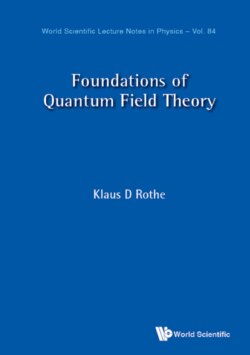Читать книгу Foundations of Quantum Field Theory - Klaus D Rothe - Страница 14
На сайте Литреса книга снята с продажи.
2.3Lie algebra of the Lorentz group
ОглавлениеConsider an infinitesimal Lorentz transformation in 3+1 dimensions. It is customary to parametrize its matrix elements as follows. In the case of we are dealing with a six-parameter group parametrized by the “velocities” associated with boosts, and the Euler angles associated with the rotations. This is just the number of independent components of an antisymmetric second rank tensor. In analogy to the rotation group it is customary to write for the matrix elements of an infinitesimal Lorentz transformation
Using the metric tensor as raising and lowering operators for the indices, we further have
We may rewrite this transformation in matrix form as follows
where denote the generators associated with the transformations in , with the property
and the matrix elements5
Here again it is implied that Lorentz indices can be raised and lowered with the aid of the metric tensor gμν = gμν. Expression (2.17) is just the infinitesimal expansion of
Explicitly we have
Hence for a pure Lorentz transformation in the −z-direction (boost in the +z direction)
where we have set
Equation (2.20) just represents the first two leading terms of the expansion of the finite Lorentz boost (2.15) in the x3-direction around θ = 0. We thus identify 0i with the generators for pure velocity transformations along the z-axis. Notice that these matrices are anti-hermitian. On the other hand, the hermitian matrices ij generate rotations in the (ij)-plane:
the generators of rotations about the z-, x- and y-axis respectively. One verifies from (2.18) that the generators of Lorentz transformations satisfy the Lie algebra
Explicitly
This algebra simplifies if we define the generators
which now satisfy the simple commutation relations6,7
reminiscent of the rotation group in four dimensions (except for the minus sign). This is not surprising, since the Lorentz transformations are connected to the four-dimensional rotation group by an analytic continuation in the parameters parametrizing the boosts, to pure imaginary values. The underlying Minkowski character of the space-time manifold is hidden in the anti-hermiticity of the operators i0 generating the boosts. Correspondingly we have for a finite transformation in space-time
where we have made the identifications
with θ the angle labelling the boost (2.16). For a pure rotation in the ij-plane,
where Jk is the generator of rotations around the k-axis (i, j, k taken cyclicly), with the explicit realization
Next, it will be our aim to obtain higher dimensional representations of the generators of the Lorentz group.
